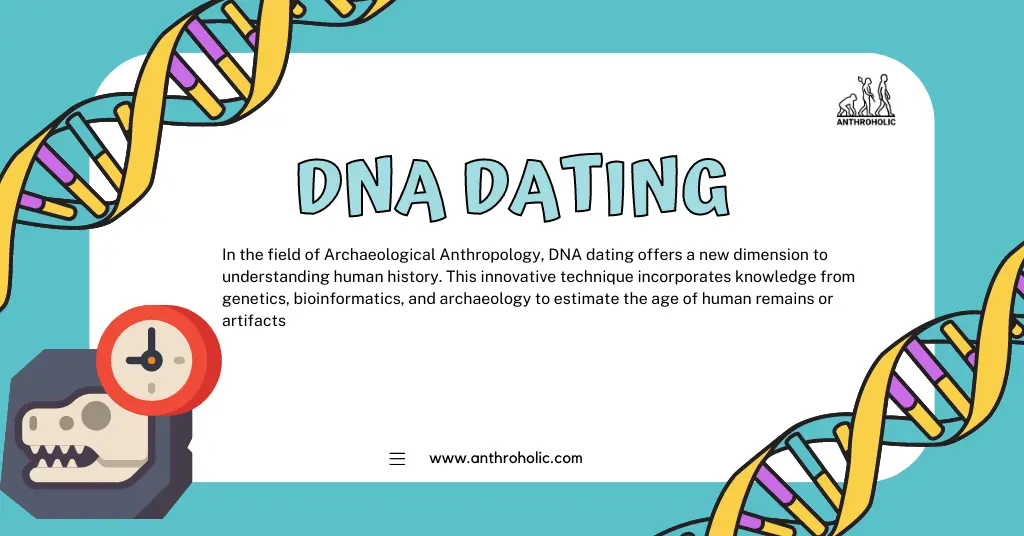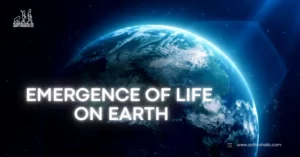AI Answer Evaluation Platform Live Now. Try Free Answer Evaluation Now
DNA Dating
In the field of Archaeological Anthropology, DNA dating offers a new dimension to understanding human history. This innovative technique incorporates knowledge from genetics, bioinformatics, and archaeology to estimate the age of human remains or artifacts. The essence of this technique revolves around the concept of ‘half-life’, a term borrowed from physics and applied innovatively in this context [1].

Understanding DNA Dating
DNA Decay
Underlying the concept of DNA dating is the principle of DNA decay. DNA, the blueprint of life, is not as immortal as its functions might suggest. Over time, it undergoes degradation – a process accelerated by factors such as temperature, moisture, and microbial activity. This degradation process, like radioactive decay, follows a somewhat predictable pattern, allowing scientists to estimate the age of biological samples by analyzing the extent of DNA degradation [2].
The Concept of Half-Life in DNA Dating
In the context of DNA dating, ‘half-life’ refers to the time it takes for half the DNA in a sample to degrade. This concept is borrowed from physics, where it originally described the decay of radioactive substances. The principle is the same: given a certain amount of a decaying substance (in this case, DNA), the half-life is the time it takes for half of it to decay. The half-life of DNA is roughly 521 years, meaning every 521 years, the DNA strands in a sample halve [3].
DNA Dating Methodology
In practice, DNA dating involves:
- Extracting DNA from a sample.
- Quantifying the amount of surviving DNA.
- Calculating the degradation rate considering the environmental conditions.
- Estimating the age of the sample based on the extent of DNA degradation.
Using this methodology, scientists have dated ancient remains and artifacts up to tens of thousands of years old [4].
Applications and Case Studies
Ancient Human Remains
DNA dating has revolutionized our understanding of human evolution and migration. For instance, the application of this technique helped identify the age of the “Cheddar Man,” the oldest complete human skeleton discovered in the UK, dating it back approximately 10,000 years [5].
Artifacts and Manuscripts
DNA dating has also been instrumental in dating ancient artifacts and manuscripts, thus helping archaeologists authenticate and contextualize their finds.
Challenges and Limitations
Despite its potential, DNA dating faces several challenges:
- It relies heavily on the preservation conditions of the sample, which can greatly influence DNA degradation.
- DNA dating cannot be used for samples older than 1 million years due to the practical limit of DNA survival.
- Contamination from modern DNA can interfere with the dating process [6].
Conclusion
DNA dating has significantly advanced archaeological anthropology by providing a new technique to date ancient remains and artifacts. The use of the ‘half-life’ concept from physics has allowed for a more precise estimation of age. However, further research is needed to overcome the limitations and unlock the full potential of this method.
Table 1: Overview of DNA Dating
| Process | Description |
|---|---|
| DNA Extraction | The DNA is carefully extracted from the sample. |
| Quantification | The amount of surviving DNA is measured. |
| Degradation Rate Calculation | Considering the environmental conditions, the rate of DNA degradation is calculated. |
| Age Estimation | The age of the sample is estimated based on the extent of DNA degradation. |
Table 2: Challenges in DNA Dating
| Challenge | Explanation |
|---|---|
| Preservation Conditions | DNA degradation can be influenced by factors such as temperature and moisture. |
| Age Limit | Due to the practical limit of DNA survival, the method is not applicable to samples older than 1 million years. |
| Contamination | Modern DNA can contaminate the sample and interfere with the dating process. |
Implications of DNA Dating in Archaeological Anthropology
Providing Biological Context
Archaeology often offers a window into past societies and cultures, revealing ancient habitats, social structures, and practices. DNA dating enhances these discoveries by providing a biological context. It helps determine the timeframes of various archaeological finds, aiding in the construction of more accurate historical narratives. For instance, scientists have used DNA dating to map ancient human migration patterns and to confirm speculations about interbreeding between Homo sapiens and Neanderthals [7].
Interdisciplinary Collaboration
DNA dating has fostered interdisciplinary collaboration between geneticists, archaeologists, anthropologists, and physicists. This exchange of ideas and methodologies leads to comprehensive and robust research. The study of the ancient horse genome, where DNA dating was integral, is a testament to this collaborative research approach [8].
Future of DNA Dating
The future of DNA dating lies in addressing its limitations while exploring its possibilities. Some of the areas that could be pivotal in shaping its future include:
- Enhanced Extraction Techniques: Future advancements may allow the extraction of DNA from older and more degraded samples, thereby increasing the scope of DNA dating.
- Refined Calculation Models: Better calculation models that account for variations in preservation conditions could increase the accuracy of DNA dating.
- Contamination Mitigation: Strategies to reduce contamination and distinguish between ancient and modern DNA could improve the reliability of DNA dating.
Despite these challenges, the potential applications of DNA dating continue to grow. There are expectations that it could be applied to other organic materials, such as plants, to provide even more detailed historical and environmental insights [9]
Table 3: Future of DNA Dating
| Future Development | Description |
|---|---|
| Enhanced Extraction Techniques | Advances may allow DNA extraction from older and more degraded samples. |
| Refined Calculation Models | More accurate models could account for variations in preservation conditions. |
| Contamination Mitigation | Improved strategies for reducing contamination and distinguishing between ancient and modern DNA. |
References
[1] Orlando, L., et al. (2013). Recalibrating Equus evolution using the genome sequence of an early Middle Pleistocene horse. Nature.
[2] Allentoft, M. E., et al. (2012). The half-life of DNA in bone: measuring decay kinetics in 158 dated fossils. Proceedings of the Royal Society B: Biological Sciences.
[3] Pääbo, S. (2014). Neanderthal Man: In Search of Lost Genomes. Basic Books.
[4] Collins, M. J., et al. (2002). The survival of organic matter in bone: a review. Archaeometry.
[5] Sykes, B. (2001). The Seven Daughters of Eve. WW Norton & Company.
[6] Hofreiter, M., et al. (2001). Ancient DNA. Nature Reviews Genetics.
[7] Green, R. E., et al. (2010). A Draft Sequence of the Neanderthal Genome. Science.
[8] Orlando, L., et al. (2013). Recalibrating Equus evolution using the genome sequence of an early Middle Pleistocene horse. Nature.
[9] Willerslev, E., et al. (2014). Fifty thousand years of Arctic vegetation and megafaunal diet. Nature.



